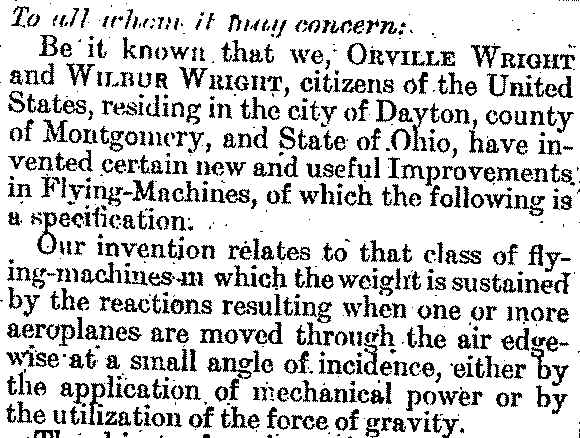|
Moderated by NW Okie! |
Volume 12 , Issue 232010Weekly eZine: (374 subscribers)Subscribe | Unsubscribe Using Desktop... |
1908 Wright Bros. Register Flying Machine

1908 - The Wright brothers register their flying machine for a U.S. patent. The Wright brothers were granted a patent by the U.S. Patent Office in 1906 for a flying machine. This patent was based on the application they had submitted in 1903 that had included a detailed description and drawings of their control system as applied to a glider. Their application described wing warping, as well as the entire system that allowed the aircraft to be controlled in forward flight. The Wrights had also stated in their application that a feature like ailerons could provide lateral control.
The Wright brothers were two of seven children born to Milton Wright (1828-1917) and Susan Catherine Koerner (1831-1889). Wilbur Wright was born near Millville, Indiana in 1867; Orville in Dayton, Ohio in 1871. The brothers never married. The other Wright siblings were named Reuchlin (1861-1920), Lorin (1862-1939), Katharine (1874-1929), and twins Otis and Ida (born 1870, died in infancy). In elementary school, Orville was given to mischief and was once expelled.[11] In 1878 their father, who traveled often as a bishop in the Church of the United Brethren in Christ, brought home a toy "helicopter" for his two younger sons. The device was based on an invention of French aeronautical pioneer Alphonse P�©naud. Made of paper, bamboo and cork with a rubber band to twirl its rotor, it was about a foot long. Wilbur and Orville played with it until it broke, and then built their own.[12] In later years, they pointed to their experience with the toy as the initial spark of their interest in flying.
The Patent - The Wright brothers wrote their 1903 patent application themselves, but it was rejected. In January 1904 they hired Ohio patent attorney Henry Toulmin, and on May 22, 1906, they were granted U.S. Patent 821393[9] for a "Flying Machine".
The patent illustrates a non-powered flying machine, namely, the 1902 glider. The patent's importance lies in its claim of a new and useful method of controlling a flying machine, powered or not. The technique of wing-warping is described, but the patent explicitly states that other methods instead of wing-warping could be used for adjusting the outer portions of a machine's wings to different angles on the right and left sides to achieve lateral (roll) control. The concept of varying the angle presented to the air near the wingtips, by any suitable method, is central to the patent. The patent also describes the steerable rear vertical rudder and its innovative use in combination with wing-warping, enabling the airplane to make a coordinated turn, a technique that prevents hazardous adverse yaw, the problem Wilbur had when trying to turn the 1901 glider. Finally, the patent describes the forward elevator, used for ascending and descending.
| View or Add Comments (0 Comments)
| Receive
updates ( subscribers) |
Unsubscribe
| © . Linda Mcgill Wagner - began © 1999 Contact Me | |
